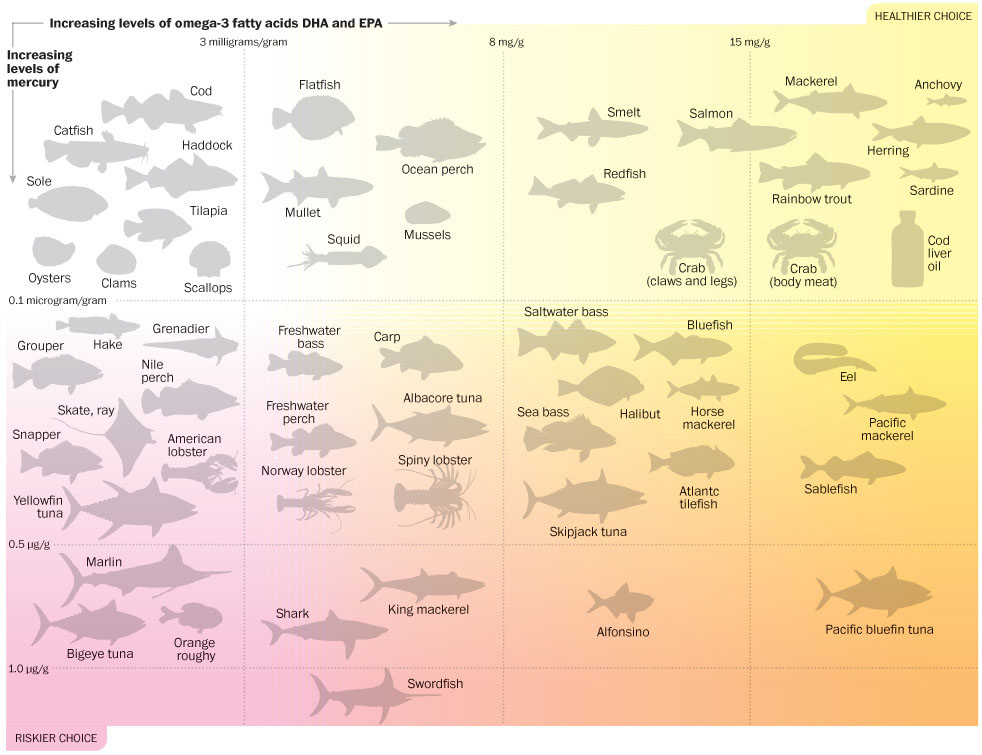How often is it ok to eat fish?

mistyh10
Posts: 42 Member
So, I REALLY love to put tuna or salmon on salads as a meal. It's an easy lunch to pack and is packed with nutrients as well as fills me up. But how many times a week is it safe to be eating tuna or other seafood? I've heard you should not be eating it every day or even more than 2x a week. Myth or fact?
0
Replies
-
I eat it once or twice a day over the years every time I diet..no issues0
-
Myth0
-
From the FDA
What You Need to Know About Mercury in Fish and Shellfish (Brochure)
SHARE
TWEET
MORE SHARING OPTIONS
EMAIL
FDA and EPA are in the process of revising this advice. Please visit Fish: What Pregnant Women and Parents Should Know to see the draft update and to provide comments. Your comments will to help finalize the new advice.
March 2004
EPA-823-R-04-005
en Español (Spanish)
Advice for:
Women Who Might Become Pregnant
Women Who are Pregnant
Nursing Mothers
Young Children
From:
U.S. Food and Drug Administration
U.S. Environmental Protection Agency
The Facts
Fish and shellfish are an important part of a healthy diet. Fish and shellfish contain high-quality protein and other essential nutrients, are low in saturated fat, and contain omega-3 fatty acids. A well-balanced diet that includes a variety of fish and shellfish can contribute to heart health and children's proper growth and development. So, women and young children in particular should include fish or shellfish in their diets due to the many nutritional benefits.
However, nearly all fish and shellfish contain traces of mercury. For most people, the risk from mercury by eating fish and shellfish is not a health concern. Yet, some fish and shellfish contain higher levels of mercury that may harm an unborn baby or young child's developing nervous system. The risks from mercury in fish and shellfish depend on the amount of fish and shellfish eaten and the levels of mercury in the fish and shellfish. Therefore, the Food and Drug Administration (FDA) and the Environmental Protection Agency (EPA) are advising women who may become pregnant, pregnant women, nursing mothers, and young children to avoid some types of fish and eat fish and shellfish that are lower in mercury.
3 Safety Tips
By following these 3 recommendations for selecting and eating fish or shellfish, women and young children will receive the benefits of eating fish and shellfish and be confident that they have reduced their exposure to the harmful effects of mercury.
1. Do not eat
They contain high levels of mercury.
Shark
Swordfish
King Mackerel
Tilefish
2. Eat up to 12 ounces (2 average meals) a week of a variety of fish and shellfish that are lower in mercury.
Five of the most commonly eaten fish that are low in mercury are shrimp, canned light tuna, salmon, pollock, and catfish.
Another commonly eaten fish, albacore ("white") tuna has more mercury than canned light tuna. So, when choosing your two meals of fish and shellfish, you may eat up to 6 ounces (one average meal) of albacore tuna per week.
3. Check local advisories about the safety of fish caught by family and friends in your local lakes, rivers, and coastal areas.
If no advice is available, eat up to 6 ounces (one average meal) per week of fish you catch from local waters, but don't consume any other fish during that week.
Follow these same recommendations when feeding fish and shellfish to your young child, but serve smaller portions.
Frequently Asked Questions about Mercury in Fish and Shellfish
What is mercury and methylmercury?
Mercury occurs naturally in the environment and can also be released into the air through industrial pollution. Mercury falls from the air and can accumulate in streams and oceans and is turned into methylmercury in the water. It is this type of mercury that can be harmful to your unborn baby and young child. Fish absorb the methylmercury as they feed in these waters and so it builds up in them. It builds up more in some types of fish and shellfish than others, depending on what the fish eat, which is why the levels vary.
I'm a woman who could have children but I'm not pregnant - so why should I be concerned about methylmercury?
If you regularly eat types of fish that are high in methylmercury, it can accumulate in your blood stream over time. Methylmercury is removed from the body naturally, but it may take over a year for the levels to drop significantly. Thus, it may be present in a woman even before she becomes pregnant. This is the reason why women who are trying to become pregnant should also avoid eating certain types of fish.
Is there methylmercury in all fish and shellfish?
Nearly all fish and shellfish contain traces of methylmercury. However, larger fish that have lived longer have the highest levels of methylmercury because they've had more time to accumulate it. These large fish (swordfish, shark, king mackerel and tilefish) pose the greatest risk. Other types of fish and shellfish may be eaten in the amounts recommended by FDA and EPA.
I don't see the fish I eat in the advisory. What should I do?
If you want more information about the levels in the various types of fish you eat, see the FDA food safety website or the EPA website at www.epa.gov/ost/fish.
What about fish sticks and fast food sandwiches?
Fish sticks and "fast-food" sandwiches are commonly made from fish that are low in mercury.
The advice about canned tuna is in the advisory, but what's the advice about tuna steaks?
Because tuna steak generally contains higher levels of mercury than canned light tuna, when choosing your two meals of fish and shellfish, you may eat up to 6 ounces (one average meal) of tuna steak per week.
What if I eat more than the recommended amount of fish and shellfish in a week?
One week's consumption of fish does not change the level of methylmercury in the body much at all. If you eat a lot of fish one week, you can cut back for the next week or two. Just make sure you average the recommended amount per week.
Where do I get information about the safety of fish caught recreationally by family or friends?
Before you go fishing, check your Fishing Regulations Booklet for information about recreationally caught fish. You can also contact your local health department for information about local advisories. You need to check local advisories because some kinds of fish and shellfish caught in your local waters may have higher or much lower than average levels of mercury. This depends on the levels of mercury in the water in which the fish are caught. Those fish with much lower levels may be eaten more frequently and in larger amounts.
For further information about the risks of mercury in fish and shellfish call the U.S. Food and Drug Administration's food information line toll-free at 1-888-SAFEFOOD or visit FDA's Food Safety website.
For further information about the safety of locally caught fish and shellfish, visit the Environmental Protection Agency's Fish Advisory website or contact your State or Local Health Department. A list of state or local health department contacts is available. Click on Federal, State, and Tribal Contacts. For information on EPA's actions to control mercury, visit EPA's mercury website.0 -
The higher on the food chain, the higher the concentration of mercury, PCBs, and other pollutants. Not a myth...this is what we've done to our oceans. Fish near Yakishima nuclear meltdown in Japan are radioactive, with Plutonium. Sad, but the oceans are not safe food sources in too many cases. Tuna and salmon should be occasional (wild caught generally safer). Sardines can be eaten more often. Also consider canned octopus...yum! Freshwater fish are iffy, depending on the source.
I write this as a preventive medicine physician. Please confirm for yourself as you can google the facts easily.0 -
Oh ok, well I eat them daily
 0
0 -
im with kittenforever i'v been eating fish everyday for the last year
MYTH to an extent do your homework on the fish your eating0 -
So, I REALLY love to put tuna or salmon on salads as a meal. It's an easy lunch to pack and is packed with nutrients as well as fills me up. But how many times a week is it safe to be eating tuna or other seafood? I've heard you should not be eating it every day or even more than 2x a week. Myth or fact?
The big cold water fish have some mercury. Tunas are high on the food chain and can be huge fish..
Sardines and salmon are ok cause they are small. The US gov makes recommendations about children and pregnant women re mercury:
http://www.fda.gov/Food/FoodborneIllnessContaminants/Metals/ucm393070.htmAdvice
Key Message
Eat 8 to 12 ounces of a variety of fish* each week from choices that are lower in mercury. The nutritional value of fish is important during growth and development before birth, in early infancy for breastfed infants, and in childhood.
Who should know
Women who are pregnant (or might become pregnant) or breastfeeding.
Anyone who feeds young children.
What to do
1. Eat 8-12 ounces of a variety of fish a week.
That’s 2 or 3 servings of fish a week.
For young children, give them 2 or 3 servings of fish a week with the portion right for the child’s age and calorie needs.
2. Choose fish lower in mercury.
Many of the most commonly eaten fish are lower in mercury.
These include salmon, shrimp, pollock, tuna (light canned), tilapia, catfish, and cod.
3. Avoid 4 types of fish: tilefish from the Gulf of Mexico, shark, swordfish, and king mackerel.
These 4 types of fish are highest in mercury.
Limit white (albacore) tuna to 6 ounces a week.
4. When eating fish you or others have caught from streams, rivers, and lakes, pay attention to fish advisories on those waterbodies.
If advice isn’t available, adults should limit such fish to 6 ounces a week and young children to 1 to 3 ounces a week and not eat other fish that week.
5. When adding more fish to your diet, be sure to stay within your calorie needs.
Why this advice is important
Fish contains important nutrients for developing fetuses, infants who are breastfed, and young children. Fish provides health benefits for the general public. Many people do not currently eat the recommended amount of fish.
Note
*This advice refers to fish and shellfish collectively as “fish.”0 -
If your concerned about mercury why not farmed fresh water fish.0
-
I had fish three times this past weekend. I was craving it. I usually only eat it 2-3 times a week at most though and it's usually wild caught cod or tuna.0
-
hmmmm - ocean decreasing water level is in part due to them little *uckers swimming around and wasting water so the more fish you eat the less they swim in oceans the more you save the planet i guess.0
-
-
This content has been removed.
-
Have you tried a "Chickpea of the Sea" sandwich? It's essentially along the same lines as a tuna/chicken salad sandwich but you coarsely chop up chickpeas instead. You can even add a dash of kelp or grind up a sheet of nori seaweed sushi wrapper if you want a fisher flavor.
http://www.theppk.com/2013/07/chickpea-salad-sammiches/0 -
Never. Fish is disgusting....0
-
as long as you are not pregnant eating tuna regularly is fine. when I first started my journey I ate a piece of salmon almost every night for over a year, that and some quinoa and edemame became my go to dinner.0
-
So, I REALLY love to put tuna or salmon on salads as a meal. It's an easy lunch to pack and is packed with nutrients as well as fills me up. But how many times a week is it safe to be eating tuna or other seafood? I've heard you should not be eating it every day or even more than 2x a week. Myth or fact?
It depends on the fish...google low and high mercury fish. Salmon is low...I eat a ton of salmon and I also like cod.0 -
Have you tried a "Chickpea of the Sea" sandwich? It's essentially along the same lines as a tuna/chicken salad sandwich but you coarsely chop up chickpeas instead. You can even add a dash of kelp or grind up a sheet of nori seaweed sushi wrapper if you want a fisher flavor.
http://www.theppk.com/2013/07/chickpea-salad-sammiches/
Omg that looks heavenly! I love chickpeas!0 -
DancingDarl wrote: »vinegar_husbands wrote: »I eat fish everyday. It's very good for you. Mostly sardines and salmon. You definitely shouldn't eat tuna everyday, though.
This chart might help: 6pkdreamer wrote: »If your concerned about mercury why not farmed fresh water fish.
6pkdreamer wrote: »If your concerned about mercury why not farmed fresh water fish.
Farmed is often full of contaminants like PCB and illegal antibiotics.
Really? Wow
I just assumed that was just a regular farm issue not fish farming..
Farmed fish in the USA are tightly regulated by the FDA and other agencies.
But it is hard to find in the stores where I shop.
http://www.nmfs.noaa.gov/aquaculture/faqs/faq_aq_101.htmlAre U.S. farm-raised fish and shellfish safe?
Yes, the U.S. laws governing the harvest and processing of seafood for human consumption are among the most stringent in the world. The responsibilities of monitoring and controlling seafood safety are divided among various agencies of the federal government and individual states. The primary federal agencies involved with seafood safety include:
Food and Drug Administration
National Oceanic and Atmospheric Administration
U.S. Department of Agriculture
Environmental Protection Agency
Consumers play an important role in seafood safety as well. When shopping for seafood, it is important to know what to look for. Read the NOAA Fishwatch Program ‘Seafood & Your Health, page for information about buying, handling, storing, and cooking seafood.0
This discussion has been closed.
Categories
- All Categories
- 1.4M Health, Wellness and Goals
- 398.2K Introduce Yourself
- 44.7K Getting Started
- 261K Health and Weight Loss
- 176.4K Food and Nutrition
- 47.7K Recipes
- 233K Fitness and Exercise
- 462 Sleep, Mindfulness and Overall Wellness
- 6.5K Goal: Maintaining Weight
- 8.7K Goal: Gaining Weight and Body Building
- 153.5K Motivation and Support
- 8.4K Challenges
- 1.4K Debate Club
- 96.5K Chit-Chat
- 2.6K Fun and Games
- 4.7K MyFitnessPal Information
- 17 News and Announcements
- 21 MyFitnessPal Academy
- 1.5K Feature Suggestions and Ideas
- 3.2K MyFitnessPal Tech Support Questions











